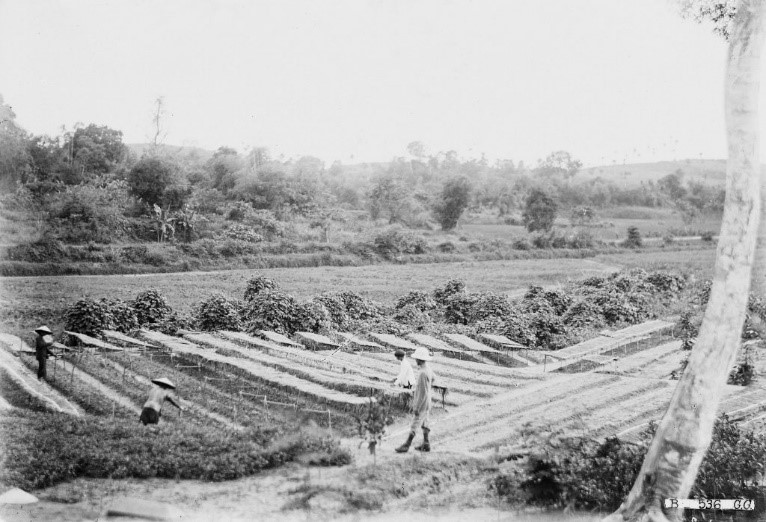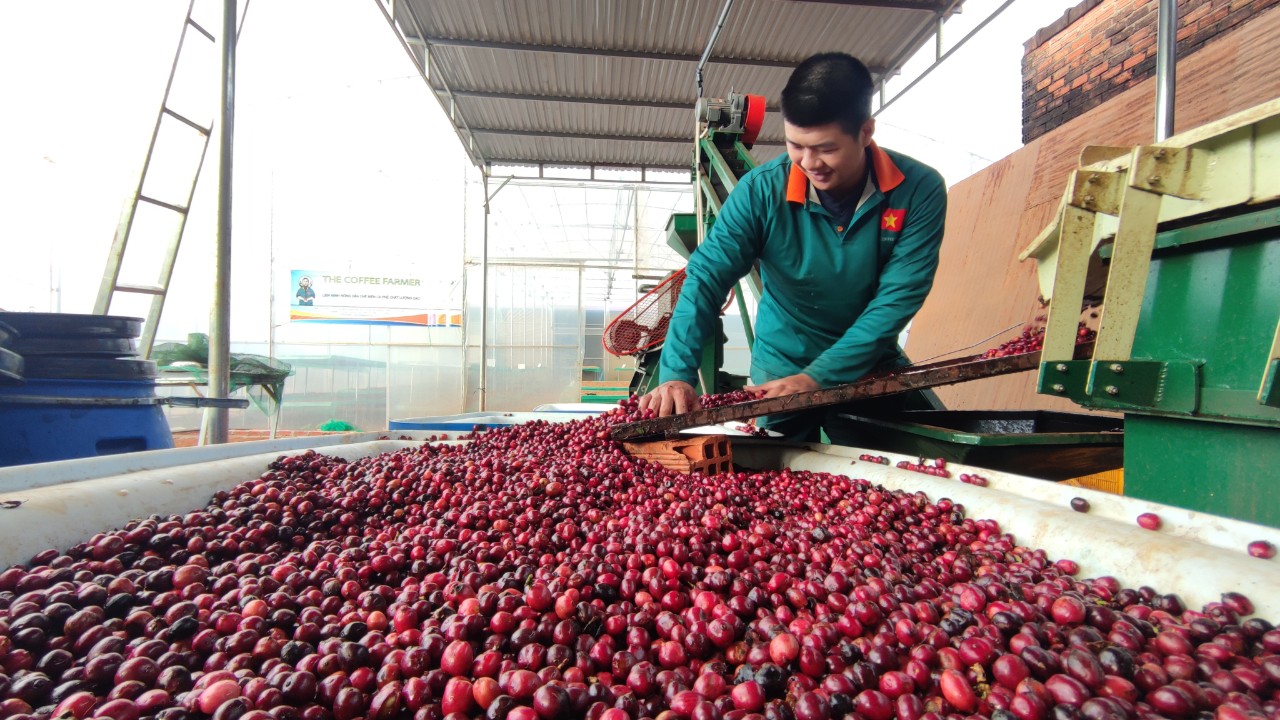Vietnam’s coffee market is a vibrant picture, reflecting the continuous transformation of an agricultural sector and culture full of potential. From the first coffee beans brought into our country to now, this beverage has become an indispensable part of Vietnamese people’s daily lives. Let’s explore more deeply the impressive development of the coffee market in this S-shaped land.
Historical Footprints of Coffee in Vietnam
The coffee tree, originating from the West, first took root in Vietnam around 1857 during the French colonial period. However, cultivation and development only really accelerated from the early 20th century, mainly on plantations operated by the French. By 1930, the coffee growing area in Vietnam had reached a significant figure of 5,900 hectares. Initially, this beverage was exclusively for the elite, French officials, and the intellectual class in major cities. Gradually, over time, Vietnamese coffee has permeated every corner of life, becoming a familiar and close beverage for the vast majority of people.

During the period from the 1960s to 1970s, coffee trees continued to be developed on some state farms in northern provinces. The planting area at times reached up to 13,000 hectares during 1964-1966. However, this development was not truly sustainable due to pest and disease problems with Arabica coffee and natural conditions not entirely suitable for Robusta coffee, leading to the liquidation of many areas. After 1975, when the country was reunified, the total coffee area nationwide was around 13,000 hectares with output reaching 6,000 tons. This is considered the starting point for a new era, when Vietnam’s coffee industry began to rise strongly, not only meeting domestic demand but also targeting international markets.
Vietnam’s Coffee Rising to Global Status
In recent decades, Vietnam’s coffee market has witnessed remarkable progress, making Vietnam one of the world’s leading coffee exporting countries, especially for Robusta coffee. The increase in production has occurred spectacularly, increasing hundreds of times in just about 15-20 years. This not only affirms strong production capacity but also elevates the position of Vietnamese coffee on the global trade map.
Besides the international market, the domestic coffee market has also seen significant changes. Instant coffee is increasingly popular thanks to its convenience, suitable for modern and busy lifestyles. Vietnamese brands like Trung Nguyên, Vinacafe, Hello 5 Coffee,… have built a solid foothold, dominating most of the domestic instant coffee market share.

Development Drivers of the Domestic Coffee Market
The dynamic development of Vietnam’s domestic coffee market is driven by many factors. The number of coffee shops springing up is increasing, from traditional street-side stalls to modern chains, creating diverse spaces for consumers to enjoy coffee. The supply system from production, processing to distribution is also becoming more professional. The coffee consumption demand of Vietnamese people has also increased rapidly in recent years, especially in urban areas.
According to studies, Vietnam’s per capita consumption level is still quite low compared to countries in the region, only about 0.5 kg per year. This shows that the domestic coffee market still has much room for development. In particular, the instant coffee segment is predicted to continue to grow strongly thanks to the young, dynamic population who prefer convenience. Competition between domestic and international brands also contributes to making Vietnam’s coffee market more vibrant and diverse.
Distinctive Cultural Features in Vietnamese Coffee Enjoyment
Coffee is not just a beverage but also a unique culture in Vietnam. The sophistication and uniqueness of Vietnamese coffee culture is clearly expressed through a very distinctive style of enjoyment. While many places in the world consider coffee a beverage for sipping, relaxing and contemplating, for Vietnamese people, coffee both helps keep alert and serves as a means of social connection.

Sitting with a cup of coffee, people can do many things: read newspapers, browse social media, chat with friends, discuss work with partners, or simply reflect on life. The distinctive flavor of Vietnamese coffee is often described as strong, bitter, and carrying characteristic notes such as almond aroma and earthy smell. Depending on the type of coffee and brewing method, the taster can also feel a light sour taste, oiliness and the aroma of flowers and fruits. A cup of coffee considered delicious is one with natural flavor, balanced between bitterness, light sourness and rich aroma.
The phin filter is perhaps the most distinctive cultural symbol of Vietnamese coffee. The process of waiting for each drop of coffee to slowly fall through the aluminum phin is an interesting experience. The result is a cup of hot black coffee, iced milk coffee, or strong iced coffee, depending on personal preference.
Discovering Health Benefits from Coffee
Vietnam’s coffee market with its product diversity from traditional phin coffee to modern instant coffee not only provides refreshing beverages but also holds many health benefits if used properly and in appropriate doses. Coffee helps us feel alert, enhances concentration and can bring other positive impacts to the body.
Coffee and Muscle Pain Reduction
Research from universities has shown that consuming a certain amount of caffeine before exercise can help reduce muscle soreness afterward. Caffeine is believed to have the ability to affect the nervous system, reducing pain perception and may contribute to enhancing muscle endurance during physical activity. About two to three cups of coffee consumed about an hour before exercise is the dose commonly mentioned in these studies.
Coffee’s Impact on Blood Circulation
Some recent studies from Japan have explored coffee’s effects on blood circulation. Initial results show that drinking coffee can improve blood circulation to extremities, such as fingers, especially in people who do not regularly consume coffee. This enhancement of blood circulation may have positive implications for overall cardiovascular health, although more in-depth research is needed for clear confirmation.
Coffee and Enhanced Cognitive Function
Besides its immediate alertness effect, coffee is also known for its ability to support cognitive function, especially memory. A notable study from Johns Hopkins University showed that caffeine can help consolidate memory for up to 24 hours after consumption. This shows that coffee is not merely a stimulant but can also positively affect the brain’s ability to learn and retain information.
Boosting Energy for Physical Activities
For people who regularly exercise or athletes, a small amount of caffeine can be extremely useful. Caffeine helps enhance glycogen storage capacity in muscles, the main energy source for prolonged and high-intensity physical activities. Research published in the Journal of Applied Physiology has shown that caffeine supplementation can significantly increase glycogen content, helping the body have more “fuel” to maintain training performance.
Potential Role in Body Protection
Beyond obvious benefits, caffeine in coffee is also being studied for its ability to protect the body, especially against age-related functional decline. Studies on animals have suggested that caffeine may help compensate for muscle strength loss due to the aging process. Although more research on humans is needed, these findings open up hope about coffee’s role in maintaining health and minimizing age-related damage.
Frequently Asked Questions about Vietnam’s Coffee Market
When did Vietnam’s coffee market begin to form?
The coffee market in Vietnam began to form in the late 19th century, when coffee trees were introduced by the French for cultivation from 1857. However, large-scale development and becoming an industry only really occurred strongly from the early 20th century.
What type of coffee is most popular in Vietnam and why?
Robusta coffee is the most popular type in Vietnam, accounting for most of the production. This is because the climate and soil conditions in the Central Highlands are very suitable for growing this type of coffee. Robusta has a strong flavor, high caffeine content and is easier to grow than Arabica.

What is the development potential of Vietnam’s domestic coffee market?
Vietnam’s domestic coffee market still has great potential because per capita consumption is still low compared to the region and the world. The growth of the middle class, the trend of drinking coffee at cafes and the convenience of instant coffee are factors driving strong domestic consumption growth in the future.
What is special about Vietnamese phin coffee drinking culture?
Vietnamese phin coffee drinking culture expresses patience and leisure. Waiting for each drop of coffee to fall through the phin is a unique tasting experience. Phin coffee is usually very concentrated and can be drunk hot or with ice and milk depending on preference and region.
What are the main health benefits of coffee?
Coffee brings many health benefits such as helping alertness, enhancing concentration, potentially helping reduce muscle pain after exercise, supporting blood circulation, improving memory and providing energy for physical activities. However, these benefits are only obtained when using coffee moderately and appropriately.
